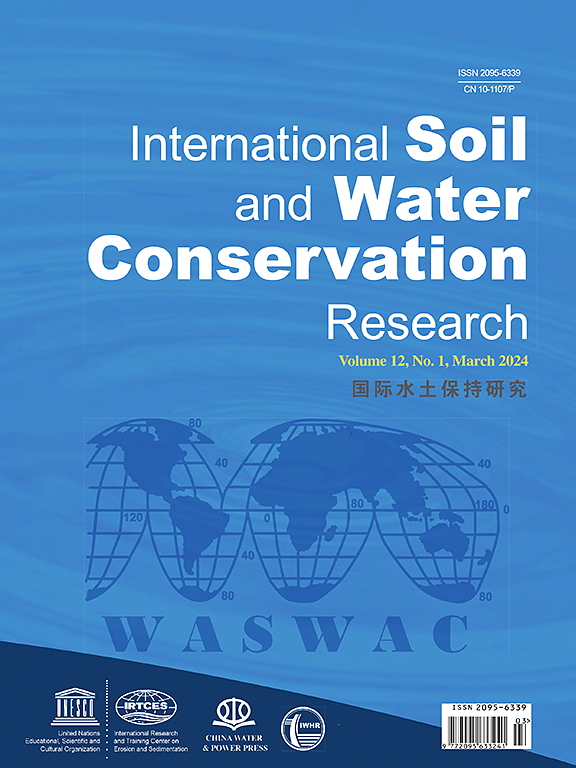The effects of armed conflict on natural resources and conservation measures in Tigray, Northern Ethiopia
IF 7.3
1区 农林科学
Q1 ENVIRONMENTAL SCIENCES
International Soil and Water Conservation Research
Pub Date : 2024-11-29
DOI:10.1016/j.iswcr.2024.11.004
引用次数: 0
Abstract
A heavy armed conflict erupted in Tigray region of Ethiopia in 2020, and the crisis continued up to 2022. This study investigates the impacts of this crisis on the status of natural resources, and Soil and Water Conservation (SWC) efforts. We collected primary data through field observations, measurements, interviews and group discussions during the wartime. We also reviewed published articles and official archives to complement the primary data, which were often challenging to obtain due to the war. We found that vegetated landscapes were damaged by artillery fire and bombings. The average depth of the surveyed bomb craters along the asphalts was 1.15 0.47 m (n = 16), whereas the average surface diameter of the craters and their rim was 2.66 0.67 m. In addition, the construction of numerous military trenches along croplands and hillsides exposed the soil particles into erosion and water pollution. The conflict also halted SWC efforts on various land uses, which were carried out annually during peacetime. For instance, 20,591 km/year of stone bunds were not constructed per year due to the crisis. Moreover, terraces and stone bunds were demolished to construct temporary ground fortifications. Indirectly, the critical energy crisis further increased pressure on forests. In this context, the poor farmers shift their livelihood strategies from the long-term sustainability to immediate economic recovery during the critical time. To conclude, the pathways of the warfare undermined the status of natural resources, and the ongoing decades of re-greening programs. Therefore, our ground-based findings can be used to prioritize and rehabilitate the war-damaged landscape services.

武装冲突对埃塞俄比亚北部提格雷自然资源和保护措施的影响
2020年,埃塞俄比亚提格雷地区爆发严重武装冲突,危机一直持续到2022年。本研究调查了这一危机对自然资源状况和水土保持(SWC)工作的影响。我们在战时通过实地观察、测量、访谈和小组讨论收集了第一手资料。我们还审查了已发表的文章和官方档案,以补充由于战争而往往难以获得的原始数据。我们发现植被被炮火和轰炸破坏了。所测弹坑沿沥青路面的平均深度为1.15±0.47 m (n = 16),弹坑及其边缘的平均表面直径为2.66±0.67 m。此外,沿着农田和山坡修建的大量军事壕沟暴露了土壤颗粒,使其受到侵蚀和水污染。冲突也停止了在和平时期每年进行的各种土地使用的SWC努力。例如,由于危机,每年没有建造20,591公里的石带。此外,梯田和石埂被拆除,以建造临时的地面防御工事。严重的能源危机间接地进一步增加了对森林的压力。在此背景下,贫困农民在关键时期将生计战略从长期可持续性转向立即恢复经济。总之,战争的路径破坏了自然资源的地位,也破坏了持续数十年的重新绿化计划。因此,我们基于地面的研究结果可以用于优先考虑和恢复战争破坏的景观服务。
本文章由计算机程序翻译,如有差异,请以英文原文为准。
求助全文
约1分钟内获得全文
求助全文
来源期刊

International Soil and Water Conservation Research
Agricultural and Biological Sciences-Agronomy and Crop Science
CiteScore
12.00
自引率
3.10%
发文量
171
审稿时长
49 days
期刊介绍:
The International Soil and Water Conservation Research (ISWCR), the official journal of World Association of Soil and Water Conservation (WASWAC) http://www.waswac.org, is a multidisciplinary journal of soil and water conservation research, practice, policy, and perspectives. It aims to disseminate new knowledge and promote the practice of soil and water conservation.
The scope of International Soil and Water Conservation Research includes research, strategies, and technologies for prediction, prevention, and protection of soil and water resources. It deals with identification, characterization, and modeling; dynamic monitoring and evaluation; assessment and management of conservation practice and creation and implementation of quality standards.
Examples of appropriate topical areas include (but are not limited to):
• Conservation models, tools, and technologies
• Conservation agricultural
• Soil health resources, indicators, assessment, and management
• Land degradation
• Sustainable development
• Soil erosion and its control
• Soil erosion processes
• Water resources assessment and management
• Watershed management
• Soil erosion models
• Literature review on topics related soil and water conservation research
 求助内容:
求助内容: 应助结果提醒方式:
应助结果提醒方式:


